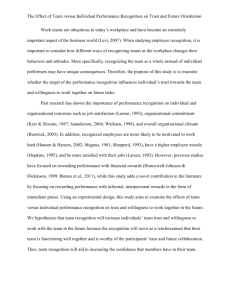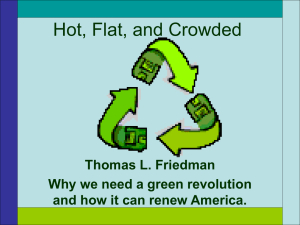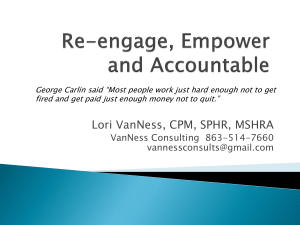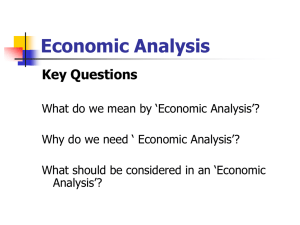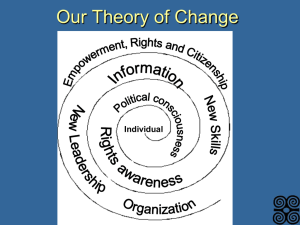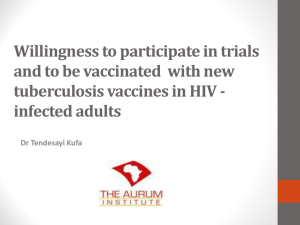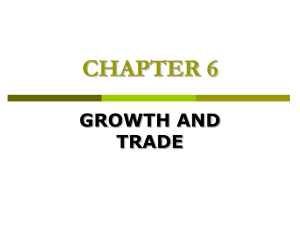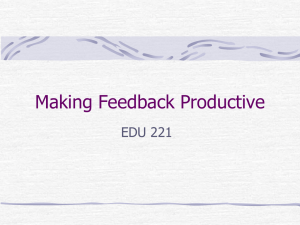Engaging Faculty in Assessment Getting to *How to Engage
advertisement
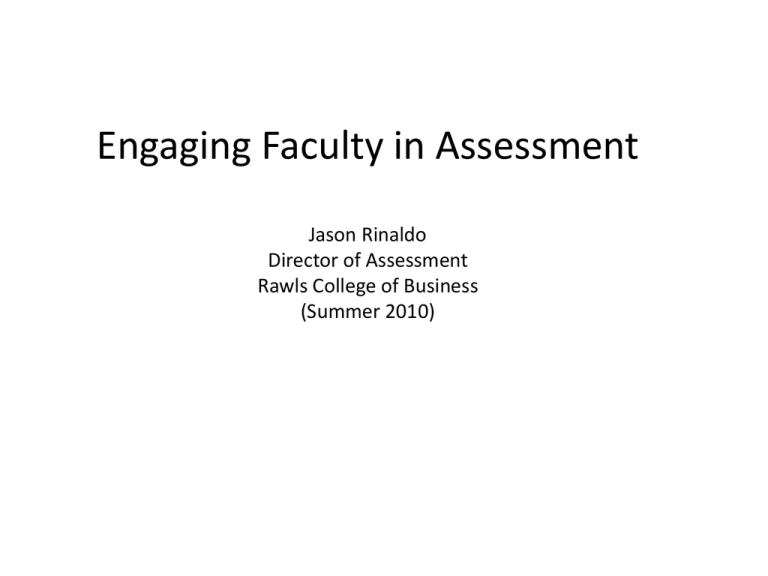
Engaging Faculty in Assessment Jason Rinaldo Director of Assessment Rawls College of Business (Summer 2010) Engaging Faculty in Assessment I believe that getting to an answer to the question “How do we engage?” involves: a) understanding why faculty may not engage. b) what barriers there are to engagement. Engaging Faculty in Assessment So, let us discuss: Why do faculty members not engage in assessment on their own? A General Framework for Discussion: Behavioral Variability and Behavioral Change People vary in their complex behaviors (obviously). Assessment participation is a complex behavior. A Framework for Discussion For any complex human behavior there is a component of ability and a component of willingness. A Framework for Discussion Variability in the behavior of assessment participation may be accounted for by: a) variability in Ability and b) variability in Willingness. c) (An interaction term, but who cares!) Level of MOTIVATION Low (Willingness) Level of KNOWLEDGE & SKILL (Ability) A Framework for Discussion High Low High Level of MOTIVATION (Willingness) Low Level of KNOWLEDGE & SKILL (Ability) High Low High Level of MOTIVATION (Willingness) Low Level of KNOWLEDGE & SKILL (Ability) High Low High Level of MOTIVATION (Willingness) Low Level of KNOWLEDGE & SKILL (Ability) High Low High Level of MOTIVATION (Willingness) Low Level of KNOWLEDGE & SKILL (Ability) High Low High …Makes me consider how our faculty distribute along these two dimensions, and how or whether they may have changed in the past 5 years or so. It also seems useful when considering individual faculty with whom I’m interacting. If they are away from average on either of these, it calls for different type of discussion and a different focus. Level of MOTIVATION (Willingness) Low Level of KNOWLEDGE & SKILL (Ability) High Low High Level of MOTIVATION (Willingness) Low Level of KNOWLEDGE & SKILL (Ability) High Low High The TTU Assessment Office is particularly well prepared to help address the Knowledge/Skill axis! Level of MOTIVATION Low (Willingness) Level of KNOWLEDGE & SKILL (Ability) High Low High A “Behaviorist” psychological model (reward/punishment to increase/decrease target behaviors) may be useful in thinking about moving people up the Motivation/Willingness scale. Level of MOTIVATION Low (Willingness) Level of KNOWLEDGE & SKILL (Ability) High Low High Generic Behaviorist Framework for Changing Level of Motivation Outcome on targeted behavior Reward Punishment (increase behavior) (decrease behavior) Add Stimulus Conventional Reward (e.g. Merit pay increase / Promotion) Conventional Punishment (e.g. addition to workload) Remove Stimulus Remove aversive stimuli (e.g. course waiver!) Remove pleasant stimuli (e.g. diminished reputation among peers) Strengths of the behaviorist framework: Provides a classification scheme for all of the approaches or interventions that we might imagine as useful to change behavior. Limitations of the Behaviorist framework: Merely provides a classification scheme for all of the approaches that we might imagine to change behavior. We know what rewards and punishments are available, and the likely downstream consequences! Lastly, the Ability and Willingness axes are “artificially orthogonal” The dimension of Willingness and that of Ability are related to each other. Rather than being crossed over each other as if independent, we would expect that as a person’s perception of their level of knowledge and ability changes, their motivation to participate would also change. Testing the model Recalcitrant Faculty Member #1: “Why should I waste my time on a completely bogus, wasteful, and burdensome bureaucratic process!?” Testing the model Recalcitrant Faculty Member #1: “Why should I waste my time on a completely bogus, wasteful, and burdensome process!?” -Very Low on X axis! -Unknown on Y axis -Statement implies that there are very specific barriers to rapid movement up on X, and that WILL would be there otherwise. The derivative communication, in the context of our framework is: “If the process can be made legitimate, or if the perception can be changed, then I might be inclined to actively participate.” Testing the model Assessment Helper #1: “Your grades are worthless to us. We’re here to help you do assessment right.” The derivative communication by this assessment person, in the context of our framework is: “I am going to offer help in moving you up on the Y-axis (knowledge/ability). I am thoroughly unimpressed with your current efforts at assessment, and you need my help.” The model clarifies that a clumsy attempt at moving someone up on Y can result in much larger movement down on X! Engaging Faculty in Assessment So, let us discuss: a) Why do faculty members not engage in assessment on their own? b) What barriers there are to engagement? Recognize the adaptive challenges we present to faculty 1. Additional work. 2. Vagueness in requirements. 3. Potential for aversive stimuli (negative feedback), usually with very little potential for reward. 4. Bureaucratic entanglement. What Economic Social Resources Psychological Merit pay Recognition from College, University, students, etc. Support: (graduate assistants, etc.) Increased sense of competence Tenure Increased status and reputation Lower stress… Improved sense of “citizenship” Increased personal satisfaction with work performance Time: Course waiver…

